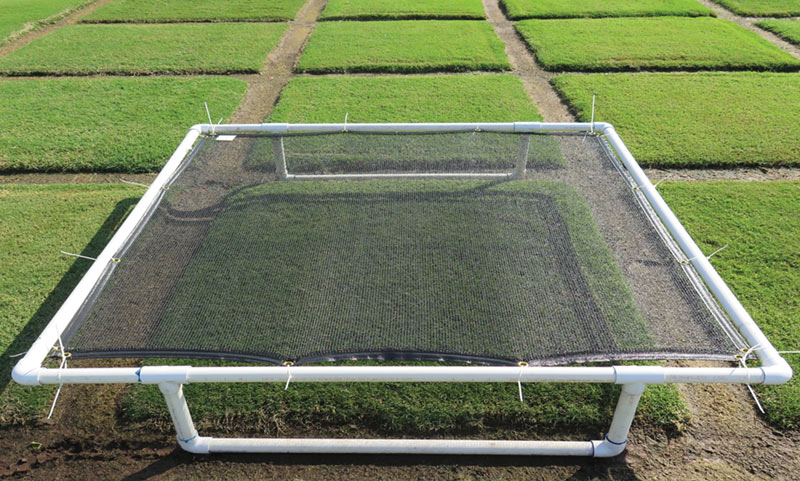
Photo courtesy of Becky Cheary
Given that about 25% of turfgrasses are managed under some shade, knowing how species and their water-use rates respond to various environments could be important for estimating water-use rates at the landscape scale.
A study was conducted at the Turf Research Station in Stillwater, Okla., to quantify the water-use rate of four bermudagrasses (Cynodon species) — TifTuf, Celebration, Latitude 36 and U3 — and two zoysiagrasses (Zoysia japonica Steud.) — El Toro and Meyer — under full sun and moderate shade.
Shade cloth over the plots was designed to reduce incoming radiation by 44%. Within the center of each 43-square-foot plot, a PVC mini-lysimeter was installed so that its canopy was even with the canopy of the grass in the plot. Evapotranspiration (ET) data were collected on three to four consecutive days each week using early-morning measurements: weighing the mini-lysimeters at field capacity the first day, then weighing them before 9 a.m. on the second, third and fourth days. Daily water-use rates were measured on consecutive days every other week on rain-free days from mid-June to mid-September (11 dates) in 2018 and 2019.
Shade cloth use reduced solar radiation about 42%, and ET by 37% to 55%. U3 bermudagrass showed the greatest reduction in ET in shade, likely because it had the most pronounced loss of turf canopy. The level of shade in this study did not visually reduce turf density or cover in the other cultivars.
Our data provide baseline information about turf water-use rates in shade under well-watered conditions. Further study under diminishing soil moisture or in combined turf and tree landscapes is warranted.
— Becky Cheary; Charles Henry Fontanier, Ph.D.; Naba Amgain; and Dustin Harris, Oklahoma State University, Stillwater, Okla.
Editor’s note: An earlier version of this summary was published in the 2019 ASA-CSSA-SSSA Meeting Abstracts, ASA-CSSA-SSSA, Madison, Wis.
Teresa Carson is GCM’s science editor.